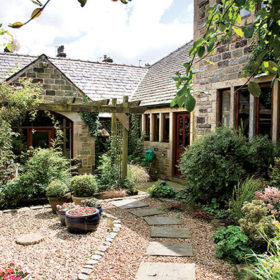
Learn from the experts with our online training course!
Use the code BUILD for 20% off
Learn from the experts with our online training course!
Use the code BUILD for 20% offGround source heat pumps (GSHPs) collect natural energy stored into the ground and convert into a usable, sustainable source of heating and hot water for the home – without the need for an additional boiler.
Depending on how it’s installed, for every unit of electricity used to power the appliance, homeowners can expect to net up to four units of heat. The result is a year-round heating system that’s energy-efficient and cost-effective to run.
Worcester’s Greenstore GSHPs have two parts: an underground circuit of piping outside the house and a heat pump unit inside. The outdoor pipe is a continuous loop, either laid horizontally or in a vertical bore hole, depending on the space and location.
The ideal situation to get maximum return from a heat pump is a well-insulated new build (or a renovated house that’s up to current Building Regulations standards). It is still possible and practical to install a system into an older property, as long as it is insulated to high levels and the radiators are sized correctly. Here’s what you need to know when specifying a ground source setup:
Determining the correct heat pump output comes down to the raw heat loss of the house, which your installer will calculate for you. As a rule,
the GSHP should be sized to accommodate 100% of the peak heating load of the property – that is, the amount of energy required to attain a comfortable internal climate on the coldest day of the year.
Combining technologiesOne of the big advantages of a ground source heat pump is that it works brilliantly in tandem with other renewables. Many homeowners choose to partner their Worcester Greenstore GSHPs with Greenskies solar panels for hot water, for example – creating a complete home heating and hot water solution. The latest addition to Worcester’s range of GSHPs is the Greenstore low energy circulation pump (LECP), which offers an improved seasonal performance factor (SPF, a measure of the unit’s efficiency across the year). The appliance is available in two formats: a combination version, where the hot water cylinder is built in; or a system variant where the storage vessel is separate from the heat pump. Both versions feature a clear LCD screen which displays easy-to-read messages to allow for simple maintenance. If you’re lucky enough to have a pool – or are planning to include one as part of your project – the Greensource LECP models have a swimming pool control to allow the water to be warmed via an external heat exchanger. |
When specified in this way, a heat pump is capable of fulfilling a household’s total heating and hot water requirement, but it’s common to fit a backup of some kind. Worcester’s Greenstore heat pumps have an internal electric heater. This ensures that additional appliances, such as a boiler, are not required.
A ground source heat pump’s efficiency is measured as its coefficient of performance (COP). This indicates how much energy is being taken from the ground compared to how much is required to run the compressor, circulating pump etc.
A properly installed pump should be able to provide between 3kW and 4kW of heat for each kW of electricity invested. This return is affected by the temperature achieved in the ground, as well as the output the appliance needs to operate at to heat the house. For example, if 3kW of electricity is required to run the pump and this provides 12kW of energy into the heating system, the COP would be 3.
Heat pumps work at their most efficient when the flow temperature is relatively low, so they’re particularly suitable for installation in conjunction with underfloor heating. This kind of setup should extract maximum performance from the system.
Worcester’s Greenstore heat pumps have the advantage of producing a 65°C maximum flow temperature, which means that they are entirely suitable for the production of domestic hot water (for taps and other outlets) in addition to outputting the lower flow temperatures that work most effectively with underfloor heating.
Each setup is unique to the property and household, but a typical GSHP installation costs between £8,000 and £12,000. This kind of heat pump features very few moving parts, which means there aren’t any annual servicing requirements.
Martyn Bridges is director of marketing and technical support at Worcester Bosch Group. For further information on Worcester’s full range of heating and hot water controls call 0330 123 9339 or visit worcester-bosch.co.ukMain image: The temperature and running status of Worcester’s Greenstore LECP heat pump system can be easily checked and monitored from one location


Comments are closed.